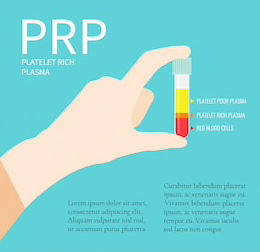Broadly speaking, blood contains 3 types of cells namely; RBC’s (Haemoglobin carriers), WBC’s (Fighting cells) and Platelets (Clotting cells). The platelets are also the store houses of many growth factors which have a natural anti-inflammatory and healing potential for the joints and soft tissues. These platelets can be separated and concentrated by the process of centrifugation. This fluid which is extracted after the centrifugation of blood is called Platelet-rich plasma.
Conditions and procedures
Platelet rich plasma (PRP) injections
-
What is Platelet-Rich Plasma?Which Conditions can be treated by PRP injections?
The major conditions where PRP injections have been found to be useful are:
Joint osteoarthritis: Knee, ankle, shoulder, hip, small joint of hand and feet, sacroiliac joints.
Soft tissue conditions:
●Tendon injuries: Tennis Elbow, Golfers elbow, MCL injuries, Adductor tendons, Gluteus medius and minimus tendons, Achilles tendon, Plantar fasciitis, Rotator cuff injuries
●Muscle injuriesUsually PRP injections are not used as first-line treatments but are reserved for specific musculoskeletal pathologies which have not responded to standard first line treatments including both pharmacological and non-pharmacological treatments.
What does the Injection procedure involve?a) Before the procedure
●The procedure of the PRP injection will be discussed with you.
●You should inform the doctor about any illness both the ongoing and those which you had in the past, medication or other substance allergies.
●Avoid Inflammatory medications for 5-7 days before the procedure.
●Inform the doctor if you are taking any blood thinning medications such as Warfarin, Plavix, etc.
b)Procedure day
●You will be asked to sign an informed consent sheet after you are satisfied with the information and the details of the procedure and agree to go ahead after all your questions have been answered.
●Procedure will be explained, which in summary would involve

●Procedure will be done with use of Local anesthetic and Ultrasound Guidance.
●Part of the body where the injection is to be given will be cleaned with antiseptic solution (Betadine or Chlorhexidine).
●Post injection aseptic dressing will be applied to the injection site.
●Post injection advice, activity modification, driving, work modification and other general instructions will be discussed.
●You will have the opportunity to ask questions if you are not clear on anything.
c) Post procedure
●You might have some discomfort which can persist for 2-3 days.
●Activity modifications including ongoing exercise programs as per advice will be discussed on the day of the procedure.
●Try to avoid anti-inflammatory medication for a week after the injection. Simple analgesics as Panadol can be taken if you don’t have allergy to those medications.
●It’s advisable to have someone to drive you back home after the procedure.
Contra-indications:
●Active infection/Sepsis in the region of the injection or anywhere else in the body
●Pregnancy, Severe metabolic systemic disorders
●Cancer or on Chemotherapy
●Allergy or reaction to previous PRP injections
●Abnormal Platelet function (blood disorder)
Please discuss with the doctor if you are unsure about anything.What are the risks and complications of PRP injections?PRP injections are generally safe. They are not synthetic injections and hence chances of reaction (although can’t be ruled out completely) by the body’s immune system are highly unlikely.
Some minor risk includes:
●Post-injection pain or soreness
●Bruising and/or bleeding risk
●Infection: PRP has natural anti-infection properties. To further reduce the risk, the injection is done under aseptic cleaning and using other sterile methods.
The PRP injections at this stage are not rebated by medicare, so you are advised to ask for the price and other rebates before the procedure.
If you have any further questions, please see the Contact Information.
 Note: If you have any more questions, feel free to contact us through email or the phone numbers provided in the Contact information (Click Here).
Note: If you have any more questions, feel free to contact us through email or the phone numbers provided in the Contact information (Click Here).